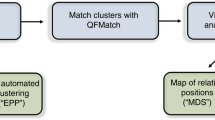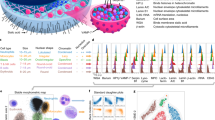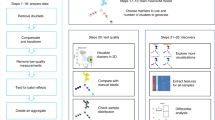Abstract
New high-dimensional, single-cell technologies offer unprecedented resolution in the analysis of heterogeneous tissues. However, because these technologies can measure dozens of parameters simultaneously in individual cells, data interpretation can be challenging. Here we present viSNE, a tool that allows one to map high-dimensional cytometry data onto two dimensions, yet conserve the high-dimensional structure of the data. viSNE plots individual cells in a visual similar to a scatter plot, while using all pairwise distances in high dimension to determine each cell's location in the plot. We integrated mass cytometry with viSNE to map healthy and cancerous bone marrow samples. Healthy bone marrow automatically maps into a consistent shape, whereas leukemia samples map into malformed shapes that are distinct from healthy bone marrow and from each other. We also use viSNE and mass cytometry to compare leukemia diagnosis and relapse samples, and to identify a rare leukemia population reminiscent of minimal residual disease. viSNE can be applied to any multi-dimensional single-cell technology.
This is a preview of subscription content, access via your institution
Access options
Subscribe to this journal
Receive 12 print issues and online access
$209.00 per year
only $17.42 per issue
Buy this article
- Purchase on Springer Link
- Instant access to full article PDF
Prices may be subject to local taxes which are calculated during checkout






Similar content being viewed by others
References
Bendall, S.C. et al. A deep profiler's guide to cytometry. Trends Immunol. 33, 323–332 (2012).
Petilla Interneuron Nomenclature Group. et al. Petilla terminology: nomenclature of features of GABAergic interneurons of the cerebral cortex. Nat. Rev. Neurosci. 9, 557–568 (2008).
Irish, J.M. et al. Single cell profiling of potentiated phospho-protein networks in cancer cells. Cell 118, 217–228 (2004).
Sachs, K. et al. Causal protein-signaling networks derived from multiparameter single-cell data. Science 308, 523–529 (2005).
Majeti, R., Park, C.Y. & Weissman, I.L. Identification of a hierarchy of multipotent hematopoietic progenitors in human cord blood. Cell Stem Cell 1, 635–645 (2007).
Tarnok, A., Ulrich, H. & Bocsi, J. Phenotypes of stem cells from diverse origin. Cytometry A 77, 6–10 (2010).
O'Brien, C.A., Kreso, A. & Dick, J.E. Cancer stem cells in solid tumors: an overview. Semin. Radiat. Oncol. 19, 71–77 (2009).
Bandura, D.R. et al. Mass cytometry: technique for real time single cell multitarget immunoassay based on inductively coupled plasma time-of-flight mass spectrometry. Anal. Chem. 81, 6813–6822 (2009).
Cornett, D.S. et al. MALDI imaging mass spectrometry: molecular snapshots of biochemical systems. Nat. Methods 4, 828–833 (2007).
Mercer, J. et al. RNAi screening reveals proteasome- and Cullin3-dependent stages in vaccinia virus infection. Cell Rep. 2, 1036–1047 (2012).
Ozsolak, F. & Milos, P.M. RNA sequencing: advances, challenges and opportunities. Nat. Rev. Genet. 12, 87–98 (2011).
Wang, Z., Gerstein, M. & Snyder, M. RNA-Seq: a revolutionary tool for transcriptomics. Nat. Rev. Genet. 10, 57–63 (2009).
Dalerba, P. et al. Single-cell dissection of transcriptional heterogeneity in human colon tumors. Nat. Biotechnol. 29, 1120–1127 (2011).
Lubeck, E. & Cai, L. Single-cell systems biology by super-resolution imaging and combinatorial labeling. Nat. Methods 9, 743–748 (2012).
Benoist, C. & Hacohen, N. Immunology. Flow cytometry, amped up. Science 332, 677–678 (2011).
Bendall, S.C. & Nolan, G.P. From single cells to deep phenotypes in cancer. Nat. Biotechnol. 30, 639–647 (2012).
Herzenberg, L.A. et al. Interpreting flow cytometry data: a guide for the perplexed. Nat. Immunol. 7, 681–685 (2006).
Qiu, P. et al. Extracting a cellular hierarchy from high-dimensional cytometry data with SPADE. Nat. Biotechnol. 29, 886–891 (2011).
Qian, Y. et al. Elucidation of seventeen human peripheral blood B-cell subsets and quantification of the tetanus response using a density-based method for the automated identification of cell populations in multidimensional flow cytometry data. Cytometry B Clin. Cytom. 78 (suppl. 1), S69–S82 (2010).
Pyne, S. et al. Automated high-dimensional flow cytometric data analysis. Proc. Natl. Acad. Sci. USA 106, 8519–8524 (2009).
Bendall, S.C. et al. Single-cell mass cytometry of differential immune and drug responses across a human hematopoietic continuum. Science 332, 687–696 (2011).
Van der Maaten, L. & Hinton, G. Visualizing (2579–2605): data using t-SNE. J. Mach. Learn. Res. 9, 2579–2605 (2008).
Kondo, M. et al. Biology of hematopoietic stem cells and progenitors: implications for clinical application. Annu. Rev. Immunol. 21, 759–806 (2003).
van Lochem, E.G. et al. Immunophenotypic differentiation patterns of normal hematopoiesis in human bone marrow: reference patterns for age-related changes and disease-induced shifts. Cytometry B Clin. Cytom. 60, 1–13 (2004).
Wakita, S. et al. Mutations of the epigenetics modifying gene (DNMT3a, TET2, IDH1/2) at diagnosis may induce FLT3-ITD at relapse in de novo acute myeloid leukemia. Leukemia published online doi: 10.1038/leu.2012.317 (8 November 2012).
Campana, D. Status of minimal residual disease testing in childhood haematological malignancies. Br. J. Haematol. 143, 481–489 (2008).
Borowitz, M.J. et al. Clinical significance of minimal residual disease in childhood acute lymphoblastic leukemia and its relationship to other prognostic factors: a Children's Oncology Group study. Blood 111, 5477–5485 (2008).
Ossenkoppele, G.J., van de Loosdrecht, A.A. & Schuurhuis, G.J. Review of the relevance of aberrant antigen expression by flow cytometry in myeloid neoplasms. Br. J. Haematol. 153, 421–436 (2011).
Loken, M.R. et al. Residual disease detected by multidimensional flow cytometry signifies high relapse risk in patients with de novo acute myeloid leukemia: a report from Children's Oncology Group. Blood 120, 1581–1588 (2012).
Bodenmiller, B. et al. Multiplexed mass cytometry profiling of cellular states perturbed by small-molecule regulators. Nat. Biotechnol. 30, 858–867 (2012).
Van der Maaten, L., Postma, E. & Van Den Herik, H. Dimensionality reduction: A comparative review. J. Mach. Learn. Res. 10, 1–41 (2009).
Blondel, V.D. et al. Fast unfolding of communities in large networks. J. Stat. Mech. 2008, P10008 (2008).
Kotecha, N., Krutzik, P.O. & Irish, J.M. Web-based analysis and publication of flow cytometry experiments. Curr. Protoc. Cytom. 10, 10.17 (2010).
Acknowledgements
The authors would like to thank N. Friedman, I. Pe'er and O. Litvin for valuable comments. The authors would also like to thank M. Minden (Princess Margaret Hospital), C. Mullighan, J. Downing and I. Radtke (St. Jude Children's Hospital) for generously providing leukemia samples for mass cytometry analysis. This research was supported by the National Science Foundation CAREER award through grant number MCB-1149728, National Institutes of Health Roadmap Initiative, NIH Director's New Innovator Award Program through grant number 1-DP2-OD002414-01 and National Centers for Biomedical Computing Grant 1U54CA121852-01A1. E.D.A. is a Howard Hughes Medical Institute International Student Research Fellow. K.L.D. is supported by Alex's Lemonade Fund Young Investigator Award and St. Baldrick's Foundation Scholar Award. S.C.B. is supported by the Damon Runyon Cancer Research Foundation Fellowship (DRG-2017-09). G.P.N. is supported by the Rachford and Carlota A. Harris Endowed Professorship and grants from U19 AI057229, P01 CA034233, HHSN272200700038C, 1R01CA130826, CIRM DR1-01477 and RB2-01592, NCI RFA CA 09-011, NHLBIHV-10-05(2), European Commission HEALTH.2010.1.2-1, and the Bill and Melinda Gates Foundation (GF12141-137101). D.P. holds a Career Award at the Scientific Interface from the Burroughs Wellcome Fund and Packard Fellowship for Science and Engineering.
Author information
Authors and Affiliations
Contributions
E.D.A., G.P.N. and D.P. conceived the study. E.D.A. and D.P. developed the methods. D.K.S. and M.D.T. implemented parallel t-SNE and cyt, respectively. E.F.S., S.C.B., K.L.D. and G.P.N. designed and performed mass and flow cytometry experiments. E.D.A., J.H.L., E.F.S., S.C.B., K.L.D., S.K. and D.P. performed the biological analysis and interpretation. E.D.A. and M.D.T. performed robustness analysis of the method. E.D.A., J.H.L., K.L.D., E.F.S. and D.P. wrote the manuscript.
Corresponding author
Ethics declarations
Competing interests
The authors declare no competing financial interests.
Supplementary information
Supplementary Text and Figures
Supplementary Methods and Supplementary Figures 1–20 (PDF 4743 kb)
Supplementary Table 1
Antibody sources, metal isotope and staining concentration for all of the antibodies used throughout the various experiments (XLSX 50 kb)
Supplementary Table 2
Experiment details, per figure. Figure and section refers to the location of the figure in the text (XLSX 13 kb)
Rights and permissions
About this article
Cite this article
Amir, Ea., Davis, K., Tadmor, M. et al. viSNE enables visualization of high dimensional single-cell data and reveals phenotypic heterogeneity of leukemia. Nat Biotechnol 31, 545–552 (2013). https://doi.org/10.1038/nbt.2594
Received:
Accepted:
Published:
Issue Date:
DOI: https://doi.org/10.1038/nbt.2594
This article is cited by
-
Latent dirichlet allocation for double clustering (LDA-DC): discovering patients phenotypes and cell populations within a single Bayesian framework
BMC Bioinformatics (2023)
-
Integrated systems immunology approach identifies impaired effector T cell memory responses as a feature of progression to severe dengue fever
Journal of Biomedical Science (2023)
-
Label-free, multi-parametric assessments of cell metabolism and matrix remodeling within human and early-stage murine osteoarthritic articular cartilage
Communications Biology (2023)
-
Combination of pembrolizumab and pelareorep promotes anti-tumour immunity in advanced pancreatic adenocarcinoma (PDAC)
British Journal of Cancer (2023)
-
Germline T cell receptor exchange results in physiological T cell development and function
Nature Communications (2023)



